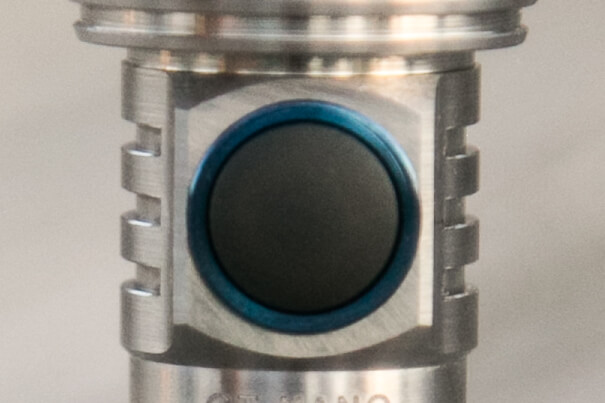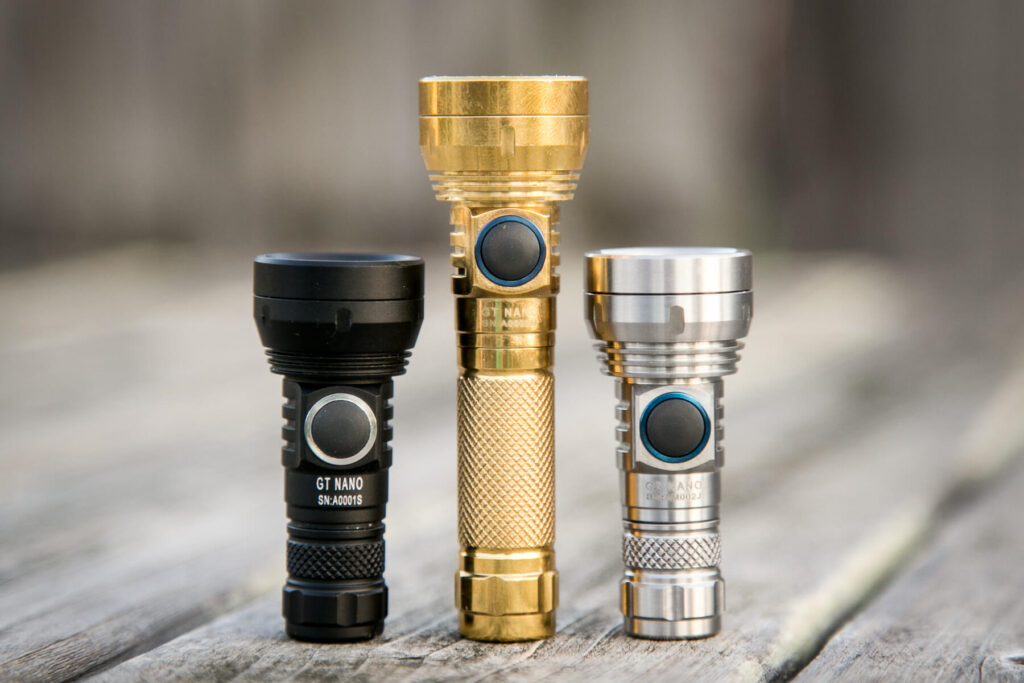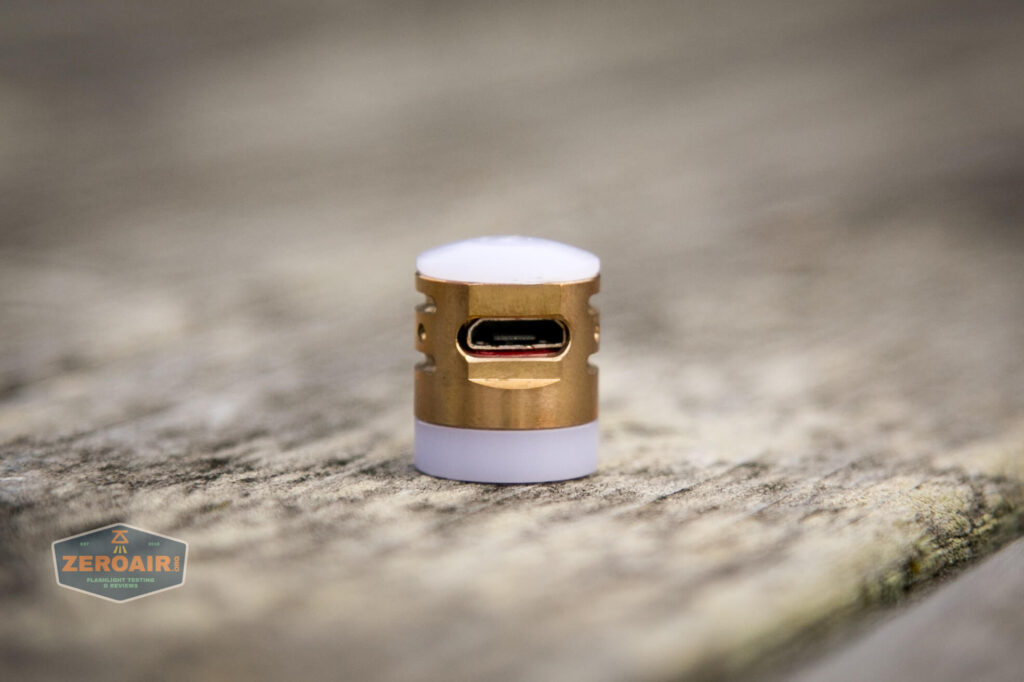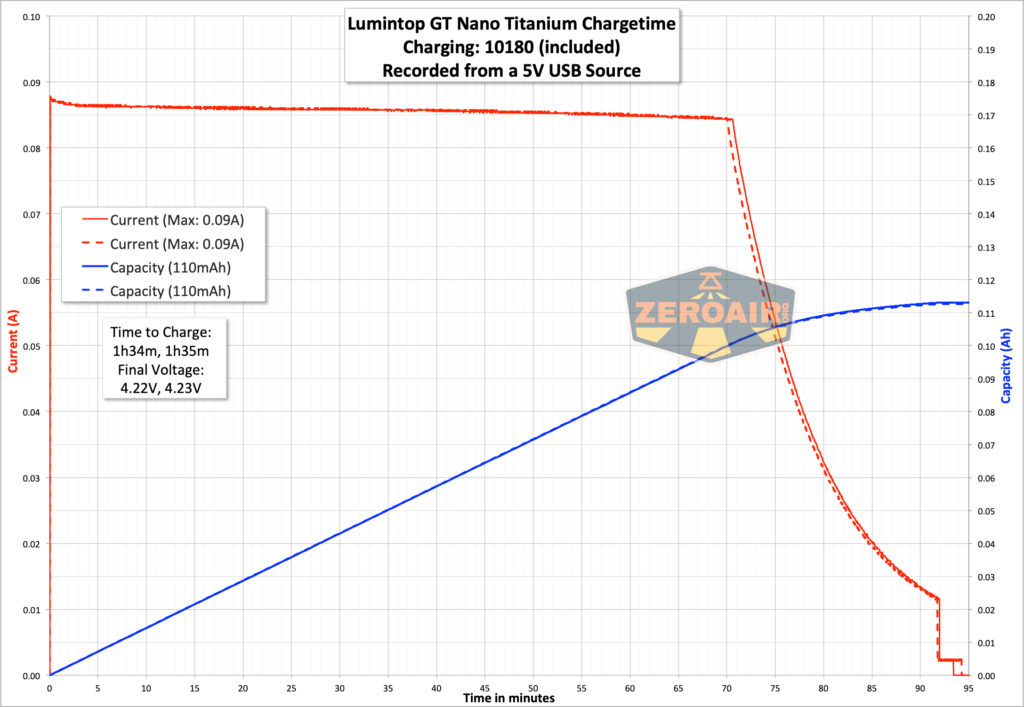Lumintop GT Nano Titanium Flashlight Review
The Lumintop GT Nano Titanium flashlight is out…. you thought the aluminum was all the rage! I was excited about it from the start, and it’s just as fun as you think it should be. Read on for some thoughts and testing!
Official Specs and Features
Here’s a referral link to the Lumintop GT Nano Titanium product page
Versions
Of course, there’s the aluminum version – I reviewed it already. There’s brass (which I also reviewed. Twice!) and copper. Lately, there is titanium (seen here), which is available in three finishes. These all have the same emitter. Mine is the “Polished” version. Also available are stonewashed and sandblasted.
Lumintop GT Nano Titanium Price
Titanium as seen in this review is going for $79.95. The other two finishes are a couple of dollars more. Pretty good deal! Mine came from NealsGadgets.com.
Short Review
I already loved the aluminum. I love the brass version a ton. I don’t think this light could be more fun. It’s the least expensive “most impressive” light I own. If you’re a titanium junkie, then this light is a must-have.
Long Review
The Big Table
| Lumintop GT Nano Titanium | |
|---|---|
| Emitter: | Osram CSLNM1.TG Flat White (1mm) |
| Price in USD at publication time: | $79.95 |
| Cell: | 1×10180 |
| Turbo Runtime Graph | High Runtime Graph |
| LVP? | Warning, then off |
| Switch Type: | E-Switch |
| Quiescent Current (mA): | |
| On-Board Charging? | Yes |
| Charge Port Type: | Micro-USB attachment |
| Charge Graph | |
| Power off Charge Port | – |
| Claimed Lumens (lm) | 450 |
| Measured Lumens (at 30s) | 187 (41.6% of claim)^ |
| Candela per Lumen | 66.3 |
| Claimed Throw (m) | 350 |
| Candela (Calculated) in cd (at 30s) | 431lux @ 5.286m = 12043cd |
| Throw (Calculated) (m) | 219.5 (62.7% of claim)^ |
| All my Lumintop reviews! | |
^ Measurement disclaimer: Testing flashlights is my hobby. I use hobbyist-level equipment for testing, including some I made myself. Try not to get buried in the details of manufacturer specifications versus measurements recorded here; A certain amount of difference (say, 10 or 15%) is perfectly reasonable.
What’s Included
- Lumintop GT Nano Titanium Flashlight
- 10180 Cell
- Lanyard
- Keyring and hook
- Micro-USB charge attachment
- Spare o-rings (2)
- Charge cable (USB to micro-USB)
- Manual
Lumintop GT Nano Titanium Package and Manual
Build Quality and Disassembly
The Lumintop GT Nano Titanium has the look of all the other GT series light, it’s just made of titanium! So it’s perfect in this regard.
I think the labeling has been improved from the black aluminum version, but I don’t know if the serial issue has been fixed.
Here’s the top-down view!
Those little fins on the head for cooling are super narrow! You can see it later but this is a very slight design change from the aluminum version. In fact, these cooling fins seem even broader than the brass cooling fins!
The bezel on my copy unscrews very easily.
The body has nice knurling, as usual.
The threads display clearly the fact that this is a titanium flashlight. They’re just as gritty as titanium threads always are.
In the tail end, there’s a big tall spring. The head has only a button for contact.
I found the driver to be “not snug” but it has to be lined up so that the e-switch operates. So tightening causes the e-switch to be off and not work. I’m not sure what’s the solution here. Probably a retaining ring?
Size and Comps
Officially:
Weight: Approximately 34g without cells
Dimensions: 24mm x 52.5mm
If the flashlight will headstand, I’ll show it here (usually the third photo). If the flashlight will tailstand, I’ll show that here, too (usually the fourth photo).
Here’s the test light with the venerable Convoy S2+. Mine’s a custom “baked” edition Nichia 219b triple. A very nice 18650 light.
And here’s the light beside my custom engraved TorchLAB BOSS 35, an 18350 light. I reviewed the aluminum version of that light in both 35 and 70 formats.
Below you can see that the brass and titanium versions are ever so slightly changed from the aluminum. They are slightly longer, and I think the difference is in the cooling fin area.
Retention and Carry
A lanyard is included for carry of the GT Nano Titanium. It attaches through a loop on the tailcap.
Also included is the key hook. With that, you’ll use the tiny split ring in the lanyard hole and then hook to the split ring.
Honestly, the split ring is probably the best bet off the top – I tried and couldn’t get the lanyard to install in this tiny hole in the tailcap.
So just plan it this way – split ring attached to the light, then either lanyard or key chain hook to the split ring. That’s likely the intended way.
There’s no pocket clip or magnet or pouch.
Power and Runtime
The Lumintop GT Nano Titanium is powered by a single lithium-ion cell. What ships and is intended for the light is a single 10180 cell – a tiny cell! These are rated at 80mAh capacity, which is a tiny capacity.
The cell is standard – slight button top.
I’ll add that Lumintop makes (and NealsGadgets.com sells) a 10440 cell extension tube for this titanium light. Just like it does for the brass, which I reviewed fully here. If you’re buying the light, you should definitely also buy the 10440 cell tube.
The 10180 fits into the GT Nano in the usual way – positive (button) end toward the head.
Here are a few runtimes. The output on this light is quite fantastic (even disregarding just the actual throw of it). You’ll note a couple of stepdowns in the runtimes – the light flashes a few times at every step down.
These runtimes are very short but, again, this is an 80mAh cell. You can’t reasonably expect extended runtimes.
I didn’t do any testing with a 10440 cell or AAA-sized body with this light. You can see my first GT Nano review for those runtimes. They’d be very similar to that testing.
Note that the manual says the GT Nano draws 2.5A on turbo. If that was the case (meaning if turbo was limited to 2.5A) then the 10440 wouldn’t have any effect on the emitter at all. But what this statement seems to mean is that a 10180 can only output 2.5A, which is what turbo is, thusly. However – and bear this in mind – the driver actually seems to be unregulated, meaning it’ll take whatever current you give it. So a 10440 cell has a higher max discharge, and you might experience some blue output. If you do, cease use of that cell. It’s “too good” for this light. There’s my disclaimer – use a 10440 at your own risk! (Read below for max current data.)
Charging
Included for charging is a “charge head.” It’s brass and has some plastic bits for protection. The plastic dome on the top (below) actually has charge indicators, too. Red for charging, and green for charging complete.
The little plastic bit seen below just unscrews – I suppose it’s just there for protection.
Here’s how the charging head fits the GT Nano. It of course can’t be used while the flashlight head is installed.
The GT Nano also has a charge adapter. Lumintop includes a cable – USB to micro-USB. It’s a very short cable.
Charging is a reasonable 0.1A or around 1C. Charge is very consistent and terminates reliably at 4.18V. Both very good things.
Modes and Currents
| Mode | Mode Claimed Output (lm) | Claimed Runtime | Measured Lumens | Tailcap Amps |
|---|---|---|---|---|
| Turbo | 450 (100%) | – | 187 | >4 |
| 4 | 40% | – | 188 | 1.18 |
| 3 | 15% | – | 111 | 0.32 |
| 2 | 1.5% | – | 9 | 0.03 |
| Moonlight | – | 0.3 | 0.01 |
Pulse Width Modulation
Narsil has PWM on moonlight (left) and 2 other intermediate modes. Turbo doesn’t have PWM though, and the 15% doesn’t either. I don’t notice the PWM on any mode, however.















































































Hardest light to program ever. The UI is complete garbage and infuriating to try to understand.